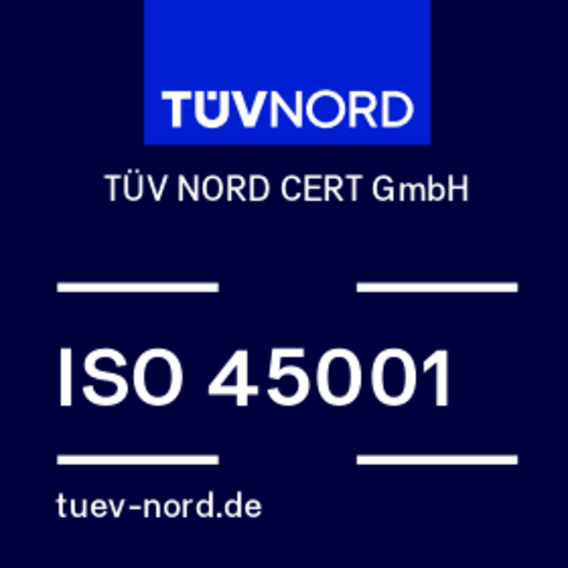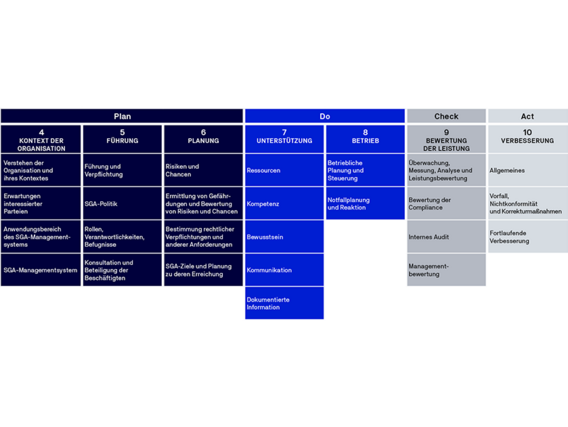ISO 45001 Certification



Healthy and motivated employees are an important factor for the economic success of a company. Occupational health and safety management systems now make a major contribution to preventing injuries and illnesses at work. They provide companies with a framework for identifying, proactively minimising and eliminating potential and existing risks in the workplace. In this way, companies not only demonstrate a sense of responsibility, but also reduce their costs through lower accident and illness rates and increase employee satisfaction at the same time.
The ISO 45001 standard supports continuous improvement in international occupational health and safety. It was developed by the International Organisation for Standardisation (ISO) and replaced the certification according to the previous British standard BS OHSAS 18001 as the basis for the certification of an internationally recognised occupational health and safety management system on 30 September 2021.
The target group for ISO 45001 certification includes organisations of all sizes and industries that want to implement an effective occupational health and safety management system to prevent injuries and illnesses in the workplace. This certification is aimed at organisations that want to demonstrate their responsibility for the health and safety of their employees while reducing costs and increasing employee satisfaction.
Securing competitive advantages through a high safety standard

The most important goal is to optimise processes in companies in all sectors so that the health and lives of employees are protected in the best possible way. A key feature is the establishment of a high-level structure with the aim of applying a standardised structure for all management system standards.
There is a clear focus on the organisation's environment and working conditions should be considered along the entire value chain - beyond the organisation's own staff. This means that external employees who are under the responsibility of the company must also be instructed in the relevant occupational health and safety measures.
Companies are also expected to identify opportunities for improving occupational safety in their own processes. Furthermore, important functions and requirements in the context of occupational health and safety management are extended and transferred to the top management level.
A new German version of the international standard for occupational safety and health was published in December 2023: DIN EN ISO 45001:2023. The requirements of ISO 45001:2018 remain largely unchanged. The standard has only been editorially revised. With the unchanged adoption of the currently valid international standard ISO 45001:2018 by the European Committee for Standardisation (CEN) as EN ISO 45001:2013, there is therefore no immediate need for action: the certificates issued remain valid without a transition period.
An integrated management system (IMS) combines a company's various management systems, such as quality, environmental, energy and occupational health and safety management, into a standardised structure. This promotes a standardised way of working, increases efficiency and transparency and offers numerous advantages:
Greater employee motivation: Transparency and clear objectives promote acceptance and identification.
An IMS improves efficiency, reduces costs, increases transparency and collaboration, and facilitates the fulfilment of legal requirements. The prerequisite for success is careful planning and implementation, with the High Level Structure (HLS) serving as a central basis to facilitate the integration of the various standards.
ISO 45001 follows the approach of risk-based thinking. This means that organisations must take a closer look than before at the opportunities and risks they face and identify them accordingly. Instead of reacting to consequences that have already occurred, organisations plan in advance how they will deal with potential consequences. The consideration of opportunities and risks can, for example, relate to investments (new machines), the organisation's own infrastructure, innovations or suppliers.
ISO 45001 certification can be deepened and extended by
ISO 45001 follows the so-called "High Level Structure" (HLS). Thanks to its standardised structure, this ensures easy integration of the new ISO 45001 management system into existing ISO 9001 or ISO 14001 management systems.
This results in two decisive advantages: Firstly, definitions and outlines can be used consistently; secondly, understanding is made easier and synergies are made possible when combining different standards and certifications. This saves time and effort when introducing and maintaining the necessary ISO 45001 processes in the company.
When conducting the audit, care must be taken to ensure that the participants specified in the standard and the accreditation requirements are adequately taken into account. The participants are more clearly named in ISO 45001 with regard to their tasks:
Where possible, management and employees of contractors on the premises of the audited organisation should be interviewed during the audit.